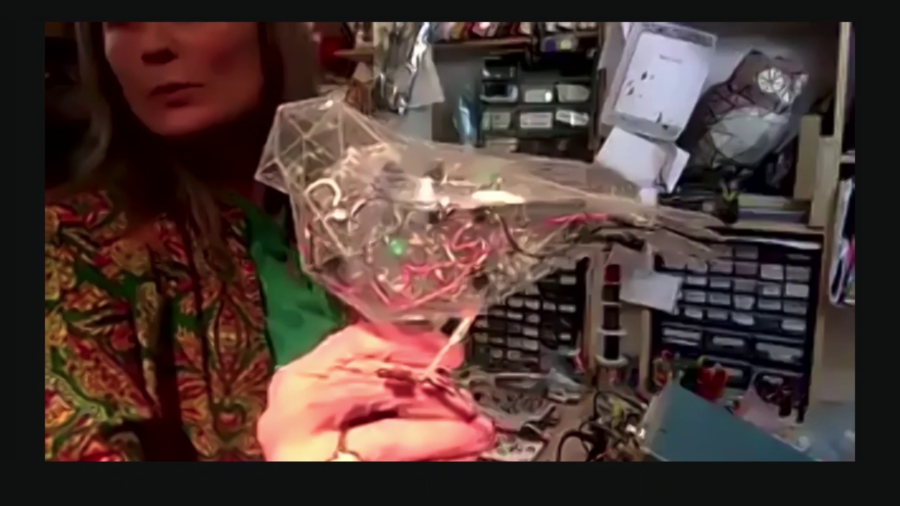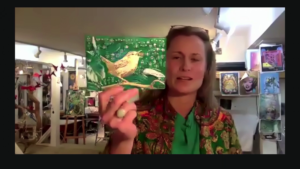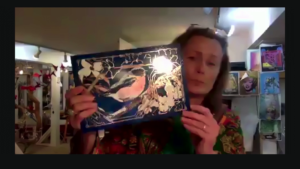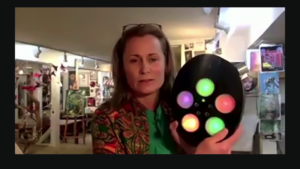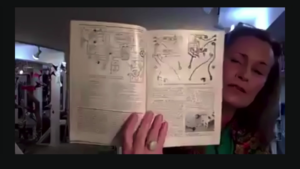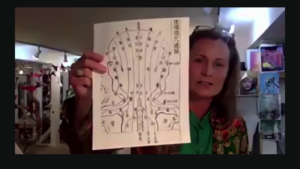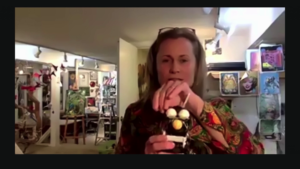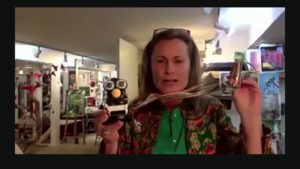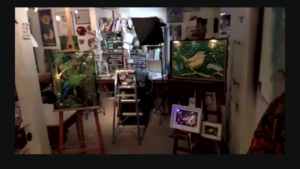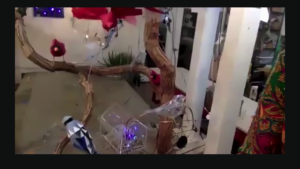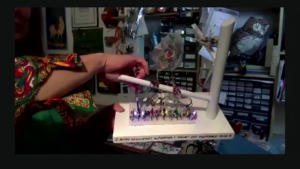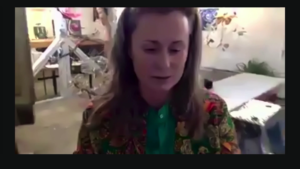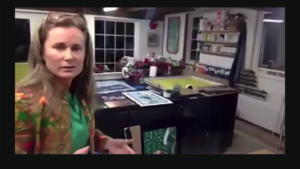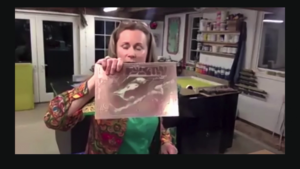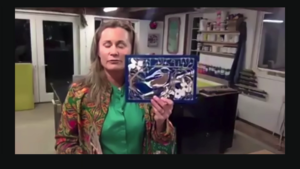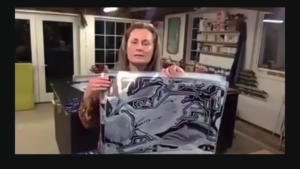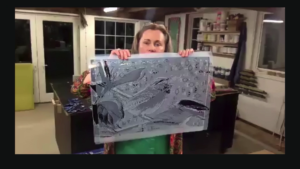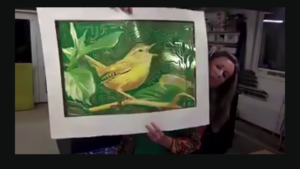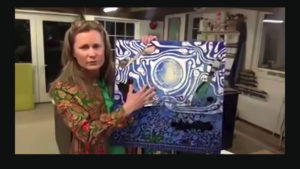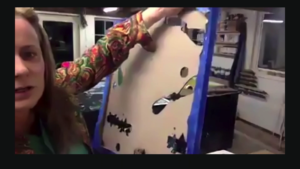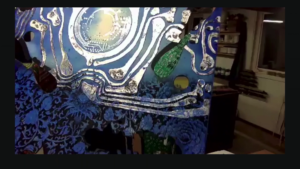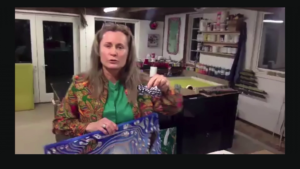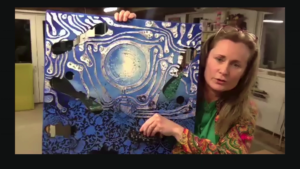Golan Levin: And we’re back. Welcome back, everyone. I’m Golan Levin, director of the Art && Code festival and professor of art here at Carnegie Mellon. And it’s my distinct pleasure to introduce to you our next speaker, Kelly Heaton, who is a Virginia-based mixed media artist working at the intersection of visual art and electrical engineering. Heaton’s sculptures and printed circuit boards depict familiar scenes of nature intersected with blinking, chirping electronics that seem oddly alive. Kelly Heaton also creates artisanal perfume. It’s my pleasure to introduce Kelly Heaton.
Kelly Heaton: Hi everybody. Thank you so much for having me. It’s great to be here. I’m going to get started— Well so, what I want to do for the thread of my talk is to help you understand how I make my circuit boards that generate birdsong and also look like birds. But before I jump directly to that, I’m going to give you a little background on why I’m doing this in the first place.
I came to electronics in my late twenties at the Media Lab. And my background was in fine arts and I identified with being a painter. But didn’t have any experience with electronics so it was like whoa, you know, how do I work with electricity? This medium is so cool. I really want to be a part of it. But in looking at electricity…how do you do that, right? You can’t really see it, so what is the form of it? So coming in initially, I had to collaborate with people because I didn’t know how to do it myself.
So I started by asking myself how could I give electricity form. So instead of having a monitor, like could I make systems of pixels that were you know three-dimensional and reconfigurable. And then could I have for example an artist’s palette that instead of mixing paint mixes colors of light. And I worked with an engineer named Steven Gray on this and that was great. But still, as an artist I felt like I’m not really touching the electricity, I’m not getting into what it really is.
So, that led me to looking at how can I learn electronics. And so you know you’ve probably many of you seen these familiar diagrams of schematics and circuit boards. And…they meant nothing to me, right, because I didn’t speak electrical engineering, initially. And I couldn’t help but to see when I would look at those diagrams, I would see things like this. This is an acupuncture diagram. And I’d be like wow you know, it seems kind of like it’s the same thing.
So, that led me to looking at other types of electronic devices such as the Furby. He’s looking kind of sad, sorry. But I for example would remove the brain and put it in another location. And I turned bunches of Furbys into a large sculpture that mirrors your body in Furby.
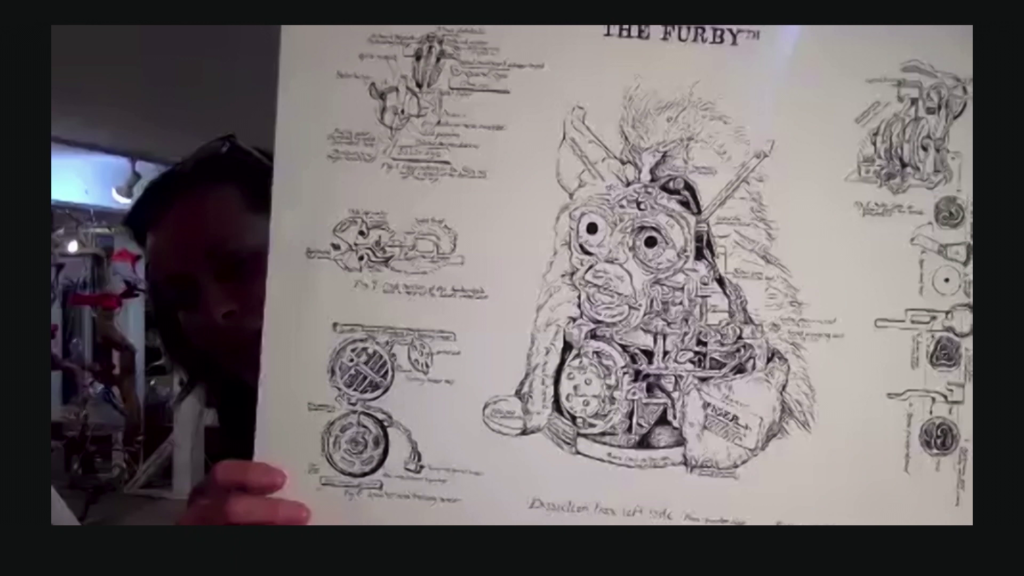
So, that was cool. And as I was doing it, I spent a lot of time like a naturalist, looking into the circuitry of the Furby and analyzing it as though it were an animal because in my mind it seem to be. And I couldn’t get around this idea that you know, the electricity that flows through computers is like the electricity that flows through bodies, and it brings computers to life, it brings animals, it brings me to life. Like…that’s fascinating to me.
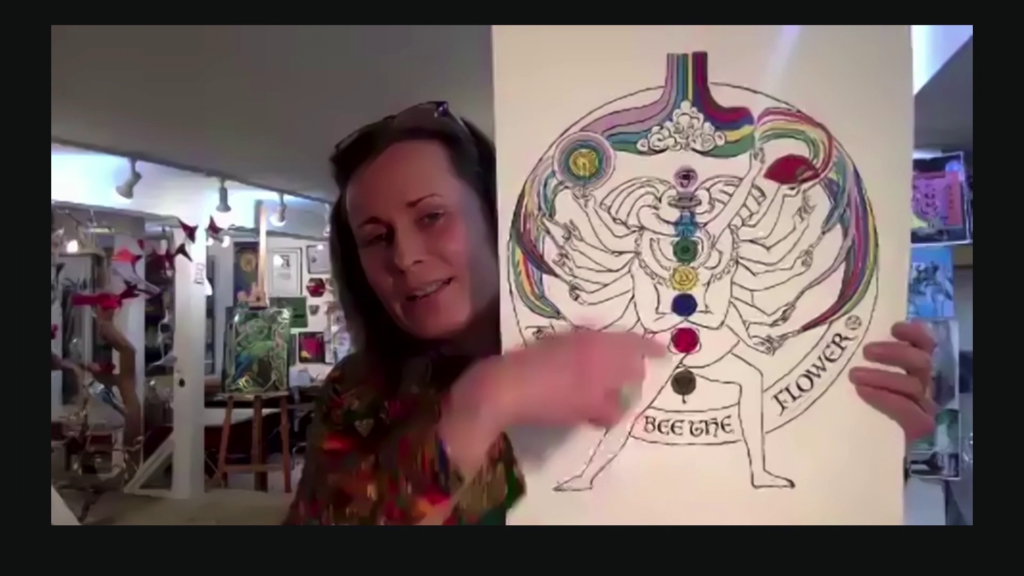
This is a diagram that I made later on actually when I was working with perfume where I indicated the chakras in bodies, with all this energy flowing around. And to me things like that look like circuits.
So. Anyway so that’s where I came from. But as I began to deepen my practice of electrical engineering and get a little bit better at making things, I wanted to be able to make my own devices not just modify Furbys or Elmos or whatever but make my own devices that were lifelike.
So. That started me on a path— It was very long. Twenty-plus years of exploring how you make lifelike circuits. And I had my first successes with insects. So, this is leading to birds, right, but chirping insects are simpler. And then from there I increased the complexity and was able to get some sounds that sound you know, kind of like birdsong.
So I’m gonna show you how I do that at my electronics bench and then moving on to my screenprinting studio, which is where I add the visual element of the circuit boards. But on my way to my electronics bench I want to do a demonstration for you of my sound circuits. Initially I was just gonna demonstrate them one by one but then I thought what the heck, let’s just plug them all in. And so that’s what I did. So, I apologize in advance as I’m walking and carrying my laptop if it’s a little bit…not such great video. But here we go.
So over here first I’m going to turn on my insects. And then I will turn on the birds and I’m gonna walk you through the soundscape.
Now as I’m walking around this side here…these are my perfume bottles. Yes, I make perfume and I’m sorry that I can’t really get into that today. It’s not enough time for that. But, to say that I experience electricity and the flow of electricity through circuits as vibration. And that same vibration is also something that we can smell. A different experience of it. So I love how all together they sound like a jungle.
Alright, so I’m going to bring you over to my electronics bench now. Turn off these guys. Kinda sad to turn them off, but anyway it’s a little distracting.
Alright. So how do I do that? Obviously I have audio amplifier circuits. But that’s not really where the exciting stuff is happening. The exciting stuff is happening in my creation of vibration. And I do that by making analog electronic oscillators. So I built a really simple one to show you what an oscillator is on a very basic level. And then I’m gonna move on and show you how that builds complexity. So.
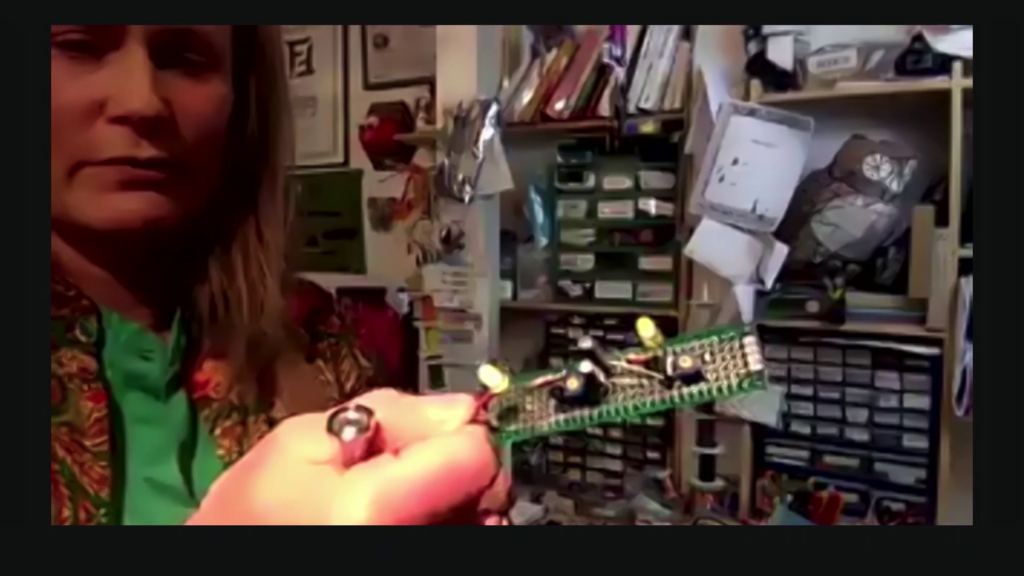
So. Here we’ve got some lights blinking back and forth. They’re oscillating, right? And if I change the resistance in the circuit, it changes the blink pattern, right. So, it’s pretty simple. And that’s how I do it. I make a bunch of oscillators and I couple them together in different ways, and based on those couplings, I can create patterns.
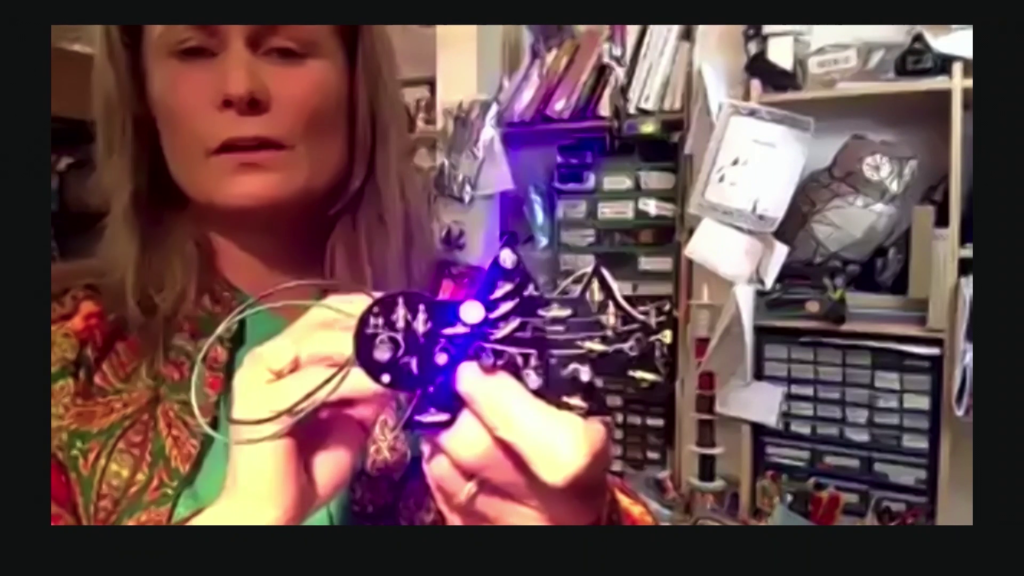
So now I’m gonna plug in another really simple circuit, and it’s one that you actually just heard. One of many. But this is a cricket. So, the pattern of the light that you see there is showing you the oscillation that’s happening in the circuit using the same components that I used in the simple blinking light before. The only difference here is that I have the audio out, and I also have a second oscillator that’s controlling the timbre of the chirp. So instead of just a boring kind of fire alarm beep, beep sine wave sound, I’m adding vibration to the quality of the sound and that’s what it sound more of that nice chirp tone.
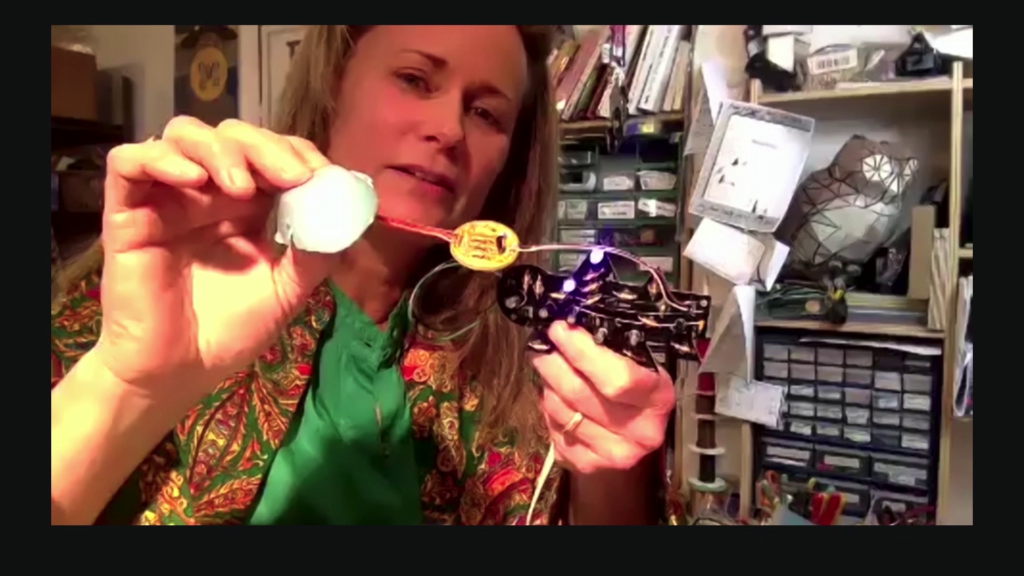
There’s one other thing I wanted to point out here since this is a conference about homemade. So, that yellow circuit board here and my piezo disc which I have in a little styrofoam egg cup because it works really well to amplify sounds, that is something that I built by myself, not because I’m crazy about making my own speakers but because Radio Shack used to make these wonderful piezoelectric buzzers and then they stopped. And suddenly my insects didn’t chirp like I wanted them to. So, I made my own. And, by the way, I put the schematics on Hackaday so that you can make one too, if you have a need to make crickets and don’t have the right piezoelectric device.
Okay. So simple oscillators, moving on to insects. From there I started breadboarding all different kinds of circuits. And it’s not like I just did this, right. It took me a really long time to do this, so don’t be intimidated, it’s just really about failing better and being really stubborn.
But anyway, so these circuits combine…in this case usually it’s like four or five oscillators with a transformer output that it is from a circuit that’s been around forever called a doorbell canary. And I put together these different circuits to make birdlike patterns. So there’s one. Then there’s another one. And then another one. I’ll hold this up so you can see it, my super dirty breadboard…wires going everywhere.

I’ll go back to this one for a second. So I’m gonna just show you that one of the cool things about using a breadboard like this— Oh, actually. This is actually demonstrating why I wanted to move on and make circuit boards, because the wires get loose and it’s easy to break stuff.
But if I just plug and unplug the wires in different patterns I can create different songs. So, I love that. I thought well, alright. I’ve gotta get away from these being… Oh, and by the way. Sorry. Before I move on I wanted to just point out this little transparent guy right here, which you saw in a large bird sculpture— I don’t know if you caught that.
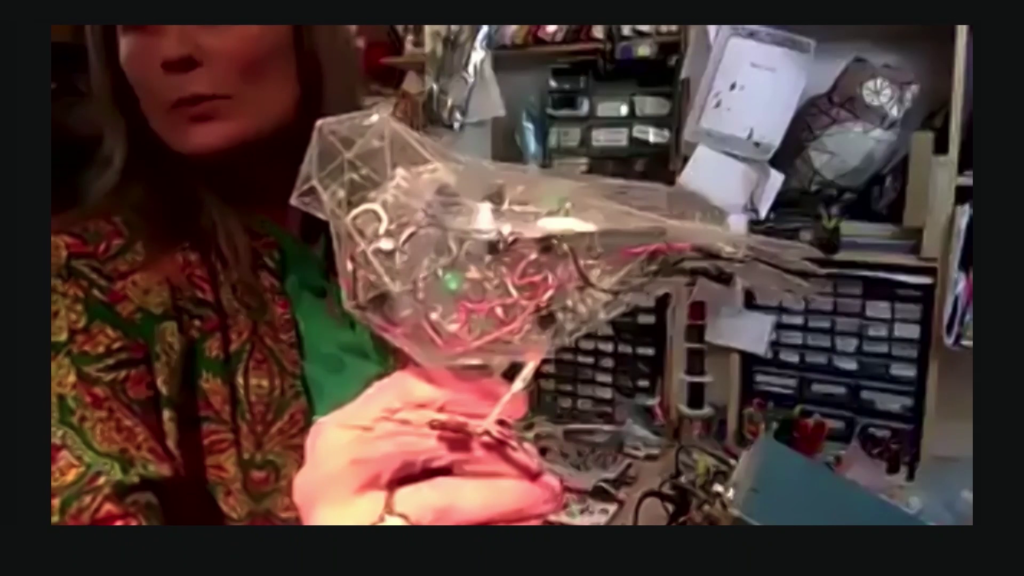
But the circuits that I just demonstrated for you are what I pack up inside of these little transparent birds.
So. Yeah. This is fun, it’s great, but they break so easily, it’s difficult to reproduce…it’s often very difficult for me to even extract a schematic from it just because the complexity of the wires and so forth, it’s really easy to make a mistake.
So I decided it would behoove me to make it as simple as possible so I had elements then that I could bricolage together to be able to make my birds and my insects faster. So that led me to this project, Deep Fake Birdsong, where I broke out five different oscillators, and then the sound circuitry is all inside of the bird. And I did that…again, just really for my own purposes. But also hopefully that it makes it easier for others to understand. So this guy, same idea. There are adjustable resistors in here inside of the circuit that will change the quality of the birdsong.

So from there, getting that circuit figured out, I was able to come up with a schematic and put it into a circuit board. So this is the same circuit that you just saw. It’s in sort of weird mode. The bird’s mad at me. It’s in some sort of really angry bird mode. Anyway, you get the idea. So by putting into a circuit board format it then enabled me to establish my schematics, have something that’s reproducible, and then continue to build on that complexity.
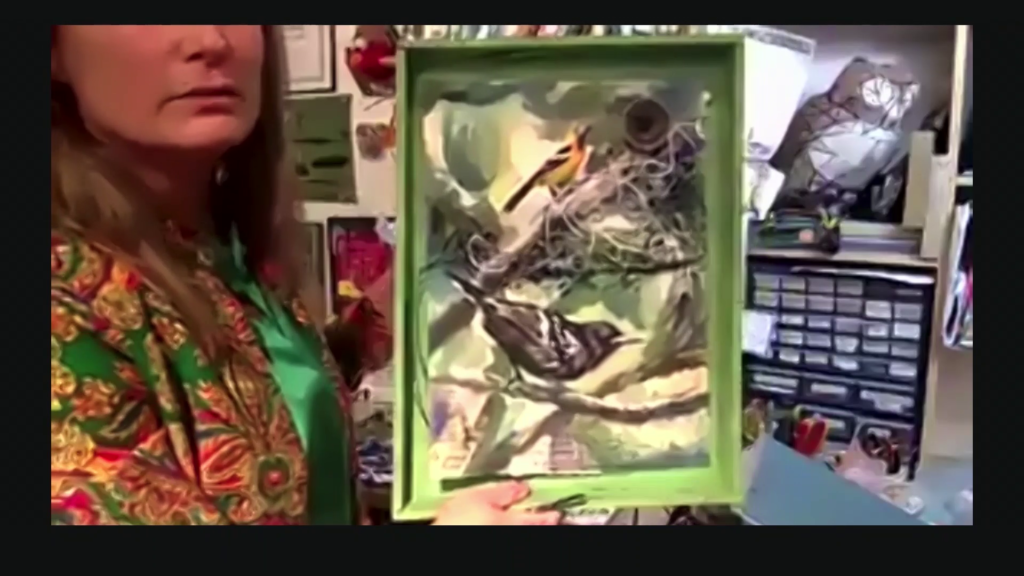
Oh, I did skip something that I wanted to show your quickly before I move on to my screenprinting. This piece here, which was back in 2018, and actually prior to that all the way back—I don’t know. I would say for the last like ten years, really. This was the modality that I was working in where I would get a bird-like circuit that worked, and then I would build it into paper. And I love that, don’t get me wrong. I’ll probably continue to do that as well.
But moving on to circuit boards, and I’m gonna move on to my screenprinting studio so apologies if my video’s bad here as I’m walking. But circuit boards are beautiful. And I I don’t know why it took me so long to get the idea. I guess because I was just so focused on trying to learn the electronics in the first place. But once I moved on to the idea of designing circuit boards it was like oh my gosh, the traces, they have such wonderful geometric patterns. And I love how they reference ornamental design from so many different cultures, and chinoiserie elements. It’s just beautiful the possibilities aesthetically with circuit traces.
But making circuit boards, so yes, you can have them made for you by a manufacturer. But there are limitations on how large they can make them. There’s limitations on color. And it is fun to work within those limitations to figure out…
Like this is just the copper layer that board I just showed you, the angry bird (it’s not always angry but it was tonight) and figuring out okay, so going from the copper layer, knowing the solder mask and the silkscreen colors that are available to me, how can I make a representational image. And that’s a great challenge and I love to do that as well. But it’s also fun to figure out what other types of fine art practice could I bring to circuit boards to make them even more beautiful and have even richer visual elements.
So this is a set of transparencies that I produce on a film printer that I have here in my studio. And using these layers, I can add colors to—well in this case a print. So the same art that can be used to generate a circuit board can also be used to generate a print.
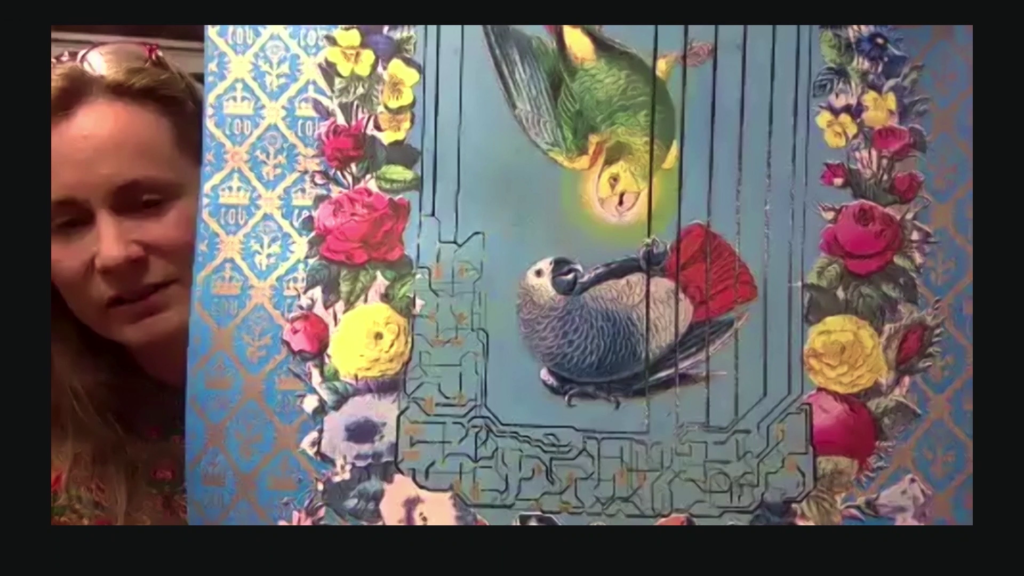
And that opens up all kinds of delightful possibilities because the more complexity I can add with color for example— This is not a functional print per se, but you can see that the birds are caged inside of a circuit board, right. And that circuit board actually generates parrot songs. But no circuit manufacturer is going to give you all of this color, and plus it’s on paper and there’s like a lot of aesthetical richness that I really love.
And so from there, what I’m working on now is to figure out how to push the circuit elements even further both aesthetically—these are traces in a… I’ll explain to you in a minute why the holes are there, but you see this is canvas on a panel where I’ve laser-cut the holes out, and this is why you see there I’m adding circuit elements back in. So…
Here’s the little cricket that you saw before… I can put my circuits back into these holes, and then there’s this whole world of possibility that opens me because at that point I can paint and I can screenprint, and I can incorporate my electronics into it. So that’s the direction I’m taking my practice now, and I’m really excited about it.
So I want to show you one other thing over here because you know, if you’re gonna make circuit boards why not make them really big, right? So I’ll show you this guy.
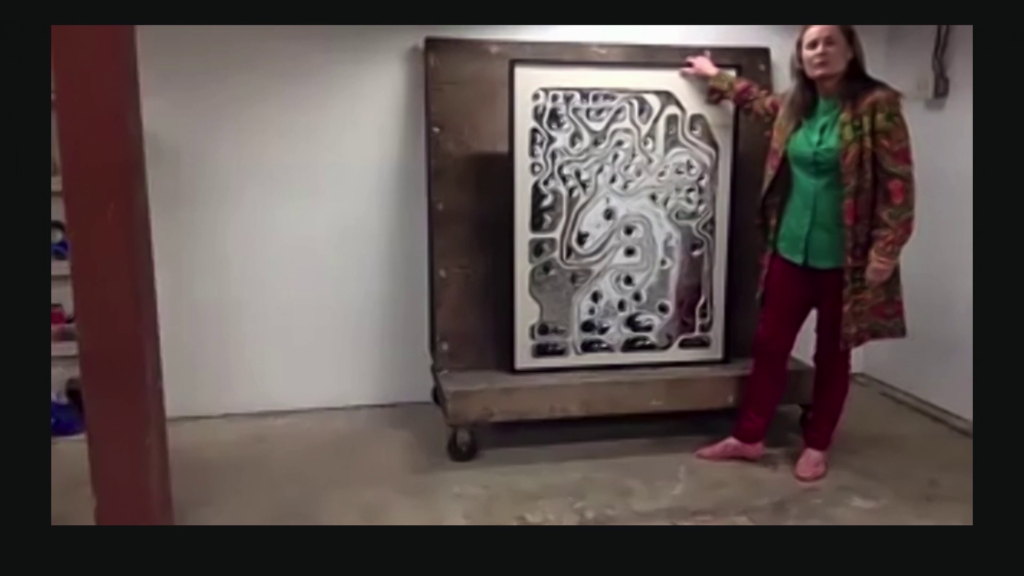
So yeah. This is where I am now. By the way, I made this all in my studio with a combination of laser-cutting with screenprint, with foiling.
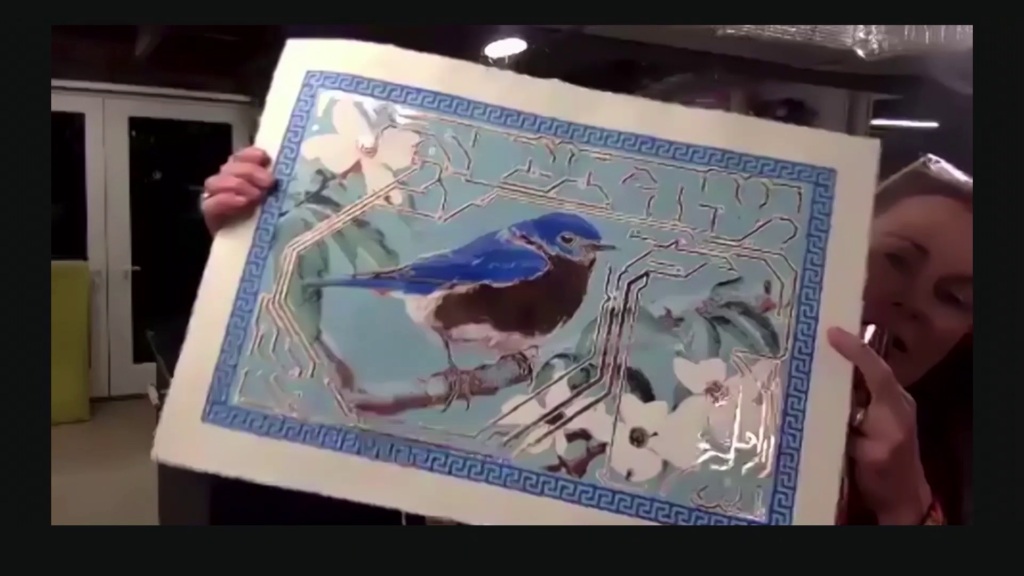
For example, this print here that I recently made for Creative Capital has foiled that I ironed onto it. They use this to make t‑shirts. So, I’ve just been looking for ways to find materials and media and methods from various different sources that I can then pull together to achieve this like lush, beautiful circuit board effect but also have the functional electronics.
I do dream of making giant circuit boards that’re actually circuit boards, so etching them, and I’ve been talking to some manufacturers about that. But… Yeah. As you can imagine like, “You wanna do what?” But…I’ll do it. I’ll get there.
And yeah, so I think that’s pretty much the tour that I wanted to give you here. Don’t know where I am on time. Well…close. So I’m gonna walk back to where my power supply is and take some questions from you guys. Yep, there’s my timer.
Golan Levin: Thank you Kelly.
Kelly Heaton: You are welcome.
Levin: Hey. Got tots of fun questions in the chat here over on Discord. That was an excellent tour, and it was lovely seeing your work both from the really sketchy and raw stuff to the really large and impressive stuff that you’re devising entirely new technologies and techniques for creating.
Do you do you ever try to imitate specific birds, or do you sort of make a circuit and then figure out what it sounds like. What’s your relationship to these birds? Are these birds that are sort of in your backyard in Virginia and you’re sort of like this is your sonic world; you’re trying to recreate these specific birds? What species are you using there, Kelly?
Heaton: [laughs] Well, the easy answer is a mockingbird, right, because they make any sounds. Yeah. So I do have a special place in my heart for mockingbirds.
The truth is that to date my skills as an electrical engineer or haven’t been good enough to say “There’s a sound. I know exactly how to reproduce it.” But to be fair to myself, I also think it’s actually a really hard problem when you’re coming at it from analog electronics because many of the effects that I get, the interactions that I get between my oscillators, are totally surprising and nothing I could have ever expected. Because I’m not sitting down and you know, being extremely deterministic about— Like I don’t do the math. I mean, yes I draw schematics and so forth. But I don’t sit down and analyze like okay, this capacitor and blah blah. I don’t put my stuff into SPICE.
So it’s definitely experimentation. But you can be sure if I hit on something that sounds familiar,…like my Pretty Bird circuit which I didn’t demonstrate to you but you can see on my Vimeo page sounds kind of like a Carolina wren. It sort of goes “pretty bird.”
Levin: I’m not sure if you’re familiar with Garnet Hertz’ work in cockroach robots, but he has made robots that are controlled by live cockroaches. And the question from the chat is have you ever worked on or wanted to make cyborg systems with insects that involve actual living things kind of collaborating with other kind of electronic components?
Heaton: The answer is absolutely not. [chuckles] There’s a reason for that. I almost— Well actually I was accepted to veterinary school when I was working on my PhD in immunology. And the reason I dropped out, and probably I should’ve always known from the beginning that I was going to be an artist. But I did not like the laboratory experimentation with animals, at all. So…mm yeah, no I like wilderness and I like to get along with my animal friends. I don’t want to… I’m not saying that all of it’s hurting them, but yeah. I’m an animal lover.
Levin: One person asked, they were like wait wait, you make perfume? And you’re just casually dropping bombs like “Oh, I dropped out of veterinary school and oh I make perfumes.” But maybe could you talk about the relationship of your perfume practice to the rest of your making practices? Or is there a relationship? Like how does that relate?
Heaton: Well, you and I talked about this recently. I guess I’m really an energy artist. So I’m just super interested in the flow of energy through all things. I’m also a tarot card reader, and I like magic. I find that when you look at it in terms of energy, and you think about perfume and the experience of perfume and how you construct it as energy, as frequency. Same as the frequency of the color fields in a painting. Same as the energy and the frequencies that happen in a sound circuit. Ultimately it’s all about the energy and the vibration, and I think that’s really the crux of where I focus my creativity.
Levin: I think this is excellent for now. We’re basically at time, so I want to thank you so much Kelly for giving us this incredible view onto your creative practice and your studio. It’s lovely. This term “energy artist” is something people are mulling over. It’s just a delight to also visit your space and to get this kind of intimate tour. Thank you so much. I hope you get to enjoy the rest of the festival now as you’ve taken— [inaudible]
Heaton: Yeah, thank you so much for having me. Thank you!
